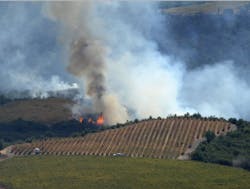California Wildfires and Related Outages Get City Thinking about a Microgrid
The City of Calistoga, California is moving forward with early-stage discussions with the non-profit Clean Coalition for a community microgrid — with risk of wildfires and utility power shutdowns driving talks.
“We are at the very initial stages of discussion. We had our first meeting with the city council last week and presented various alternative solutions to improving electric reliability and providing resilience to the community during times of high fire threat. A community microgrid solution was chosen as the most viable option for effectiveness and timeliness,” Clean Coalition Managing Director Frank Wasko explained in an interview.
Pacific Gas & Electric’s (PGE) bankruptcy filing, the past year’s wildfires and wildfire risks from utility transmission and distribution (T&D) lines all factor into the discussions, Wasko told Microgrid Knowledge.
“The city council agrees that while PG&E’s Public Safety Power Shutoff (PSPS) program reduces wildfire risk, their local community suffers. Their community needs and deserves regular access to electricity like all other electric utility customers, and resolving this issue is time-sensitive,” he said.
Outages shut down an economy
Calistoga’s city council expressed support for solutions centered on renewable energy and distributed energy resources (DER), Wasko added.
Clean Coalition has designed and participated in the deployment of community solar-plus-storage microgrids around the US, including completing a feasibility assessment of options for VMWare’s main campus in Palo Alto. VMWare last November announced it was moving forward and working together with the City of Palo Alto on plans to build a campus-community microgrid.
Carrying out a community microgrid feasibility study involves staging, planning, and engineering, Wasko explained.
Businesses can’t operate without power, and visitors to California’s beautiful wine country go home…
“Generation resources and energy storage options must be determined; energy storage options can be calculated for both resilience during grid outages and for possible revenue streams from grid services during normal operations,” Wasko said.
Ths includes calculation of the cost of the outage — or the value of resilience (VOR) to the community, he said.
The VOR “provides an important metric in assessing where to start with a project of this scale and how to plan for its growth in coverage, increasing its value to the community. These are all elements that will be further explored in the feasibility assessment,” Wasko said.
The key challenge for any community microgrid for Calistoga centers on being able to safely, reliably and cost-effectively deliver electricity when PGE turns off power for fire safety.
Power outages shut down the town’s economy during wildfire season, he said.
“Businesses can’t operate without power, and visitors to California’s beautiful wine country go home. The hospitality and services industries lose revenue. Residents with home-based businesses who rely on Internet connections are also impacted. PG&E did a PSPS shutoff to Calistoga in October 2018 and scheduled another one in November (although it wasn’t executed on), so it is fresh in everyone’s mind,” Wasko said.
Pathways forward
Wasko emphasized that it’s too early in the information-gathering stage of the process to say exactly what may come up. He did point out that, “there is always much discussion around priority tiers of loads, since there is a cost involved in the capability to maintain operations during a grid outage.”
Looking ahead, Wasko laid out what Clean Coalition will be doing to advance the project.
“We need to complete a feasibility assessment that includes local maximum loads and load profiles, existing generation resources, sites for various new generation resources, costs of outages, VOR, project cost and timeline estimates, etc., and then present results to and get approval from the city council to move forward. The next major step is discussing this solution with PG&E and determining pathways forward.”
Join Microgrid Knowledge at Microgrid 2019: Shaping the New Electric Grid, May 14-16 in San Diego, California.
